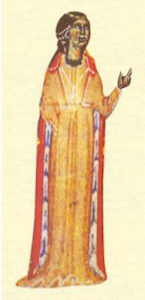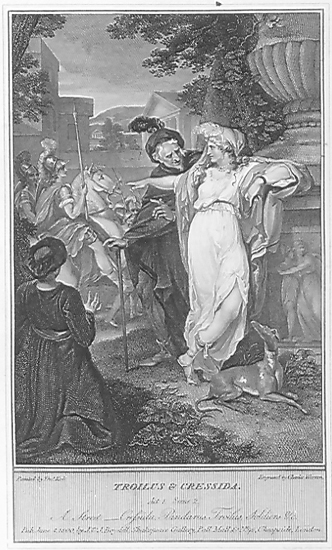|
Azalais D'Altier
Azalais or Azalaïs d'Altier was an early-13th-century trobairitz. She was from Altier in the Gévaudan. She has sometimes been confused with Almucs de Castelnau. Azalais wrote "Tanz salutz e tantas amors", the only '' salut d'amor'' by a woman. It comprises 101 verses of rhyming couplets. Its purpose was to reconcile two lovers, and it was addressed to a woman, possibly Clara d'Anduza. Its similarity in tone to Clara's '' canso'' "En greu esmay et en greu pessamen" gives the impression that it may have been written in response. Azalais was well known in troubadour circles, for Uc de Saint-Circ addressed his "Anc mais non vi temps ni sazo" to her in its '' tornada''. Nonetheless, the great troubadour ignored her when composing the '' vidas''. Azalais herself was a woman of learning, and she must have been familiar with the Matter of Rome through the ''Roman de Troie'' of Benoît de Sainte-Maure, which she references in her ''salut'': There is today a street named "Rue Azalais ... [...More Info...] [...Related Items...] OR: [Wikipedia] [Google] [Baidu] |
Trobairitz
The ''trobairitz'' () were Occitania, Occitan female troubadours of the 12th and 13th centuries, active from around 1170 to approximately 1260. ''Trobairitz'' is both singular and plural. The word ''trobairitz'' is first attested in the 13th-century romance (heroic literature), romance ''Romance of Flamenca, Flamenca''. It comes from the Provençal word ''trobar'', the literal meaning of which is "to find", and the technical meaning of which is "to compose". The word ''trobairitz'' is used very rarely in medieval Occitan language, Occitan, as it does not occur in lyrical poetry, grammatical treatises or in the Vida (Occitan literary form), biographies (''vidas'') of the ''trobairitz'' or troubadours. It does occur in the treatise ''Doctrina d'acort'' by Terramagnino da Pisa, written between 1282 and 1296. He uses it as an example of a word the plural and singular of which are the same..: "which are correctly used only with flexional endings in all numbers ... ''trobayritz''" ('' ... [...More Info...] [...Related Items...] OR: [Wikipedia] [Google] [Baidu] |
Roman De Troie
(''The Romance of Troy'') by Benoît de Sainte-Maure, probably written between 1155 and 1160,Roberto Antonelli "The Birth of Criseyde - An Exemplary Triangle: 'Classical' Troilus and the Question of Love at the Anglo-Norman Court" in Boitani, P. (ed) ''The European Tragedy of Troilus'' (Oxford: Clarendon Press) 1989 pp.21-48. is a 30,000-line epic poem, a medieval retelling of the theme of the Trojan War. It inspired a body of literature in the genre called the , loosely assembled by the poet Jean Bodel as the Matter of Rome. The Trojan subject itself, for which de Sainte-Maure provided an impetus, is referred to as the Matter of Troy. influenced the works of many in the West, including Chaucer and Shakespeare. In the East it was translated into Greek as ''The War of Troy'' (), by far the longest medieval Greek romance. Of medieval works on this subject, only Guido delle Colonne's ''Historia destructionis Troiae'' was adapted as frequently. Benoît's sources for the narrativ ... [...More Info...] [...Related Items...] OR: [Wikipedia] [Google] [Baidu] |
Trobairitz
The ''trobairitz'' () were Occitania, Occitan female troubadours of the 12th and 13th centuries, active from around 1170 to approximately 1260. ''Trobairitz'' is both singular and plural. The word ''trobairitz'' is first attested in the 13th-century romance (heroic literature), romance ''Romance of Flamenca, Flamenca''. It comes from the Provençal word ''trobar'', the literal meaning of which is "to find", and the technical meaning of which is "to compose". The word ''trobairitz'' is used very rarely in medieval Occitan language, Occitan, as it does not occur in lyrical poetry, grammatical treatises or in the Vida (Occitan literary form), biographies (''vidas'') of the ''trobairitz'' or troubadours. It does occur in the treatise ''Doctrina d'acort'' by Terramagnino da Pisa, written between 1282 and 1296. He uses it as an example of a word the plural and singular of which are the same..: "which are correctly used only with flexional endings in all numbers ... ''trobayritz''" ('' ... [...More Info...] [...Related Items...] OR: [Wikipedia] [Google] [Baidu] |
Anne Klinck
Anne Lingard Klinck (; January 4, 1943 – July 7, 2023) was a Canadian academic and writer. Her work focused on the classics and was an authority on the female voice in lyric poetry. Early life Klinck was born in Chester, England on January 4, 1943 to British-Canadian father, Sydney Hibbert, as Anne Lingard Hibbert. Education Klinck received a bachelor's and a master's degree from the University of Oxford. She also has a master's degree from McGill University and she also has a master's and a PhD from the University of New Brunswick. Career Klinck worked at the University of New Brunswick (UNB) for eighteen years before retiring as Professor Emerita. While working at UNB she co-directed the English programs. Klinck was an authority on the female voice in lyric poetry. Death Klinck died from esophageal cancer on July 7, 2023, at the age of 80. Selected publications * ''Animal Imagery in Wulf and Eadwacer and the Possibilities of Interpretation'', Papers on Language ... [...More Info...] [...Related Items...] OR: [Wikipedia] [Google] [Baidu] |
Matilda Bruckner
Matilda Tomaryn Bruckner is an American scholar of medieval French literature. She is an authority on French romance from the twelfth and thirteenth century, and author and editor of four books on romance, Chrétien de Troyes, and the women troubadours. Professional career Bruckner received her A.B. from Bryn Mawr College and her M.Phil. and Ph.D. from Yale University. She taught at Princeton University for eight years, before accepting a position at Boston College Boston College (BC) is a private university, private Catholic Jesuits, Jesuit research university in Chestnut Hill, Massachusetts, United States. Founded in 1863 by the Society of Jesus, a Catholic Religious order (Catholic), religious order, t ... in 1983, where she is a professor of French. Publications *''Chrétien Continued: A Study of the Conte du Graal and its Verse Continuations''. New York: Oxford UP, 2009. *''Songs of the Women Troubadours'', with Laurie Shepard and Sarah White. New York: Garland, 1995 (rev ... [...More Info...] [...Related Items...] OR: [Wikipedia] [Google] [Baidu] |
Montpellier
Montpellier (; ) is a city in southern France near the Mediterranean Sea. One of the largest urban centres in the region of Occitania (administrative region), Occitania, Montpellier is the prefecture of the Departments of France, department of Hérault. At the 2020 census, 299,096 people lived in the city proper, while its Functional area (France), metropolitan area had a population of 813,272. The inhabitants are called ''Montpelliérains''. In the Middle Ages, Montpellier was an important city of the Crown of Aragon (and was the birthplace of James I of Aragon, James I), and then of Kingdom of Majorca, Majorca, before its sale to France in 1349. Established in 1220, the University of Montpellier is one of the List of oldest universities in continuous operation, oldest universities in the world and has the oldest medical school still in operation, with notable alumni such as Petrarch, Nostradamus and François Rabelais. Above the medieval city, the ancient citadel of Montpelli ... [...More Info...] [...Related Items...] OR: [Wikipedia] [Google] [Baidu] |
Tydeus
Tydeus (; Ancient Greek: Τυδεύς ''Tūdeus'') was an Aetolian hero in Greek mythology, belonging to the generation before the Trojan War. He was one of the Seven against Thebes, and the father of Diomedes, who is frequently known by the patronymic ''Tydides''. Life Tydeus was a son of Oeneus and either Periboea, Oeneus's second wife, or Gorge, Oeneus's daughter. He was the husband of Deipyle, the mother of Diomedes. Tydeus was banished from Calydon by his uncle Agrius because he had killed either his brother or a different uncle or six of his cousins. He travelled to Argos, where he married Deipyle, daughter of king Adrastus. Seven against Thebes Gathering of the Seven While housing Tydeus, King Adrastus of Argos also lodged Polynices, the exiled son of Oedipus who had shared the rule of Thebes with his brother Eteocles before he was expelled by the latter. Late one night, the two young exiles got into a fierce dispute over the guest room in Adrastus's palace. Awake ... [...More Info...] [...Related Items...] OR: [Wikipedia] [Google] [Baidu] |
Troilus
Troilus ( or ; ; ) is a legendary character associated with the story of the Trojan War. The first surviving reference to him is in Homer's ''Iliad,'' composed in the late 8th century BC. In Greek mythology, Troilus is a young Troy, Trojan prince, one of the sons of King Priam (or Apollo) and Hecuba. Prophecies link Troilus' fate to that of Troy and so he is ambushed and murdered by Achilles. Sophocles was one of the writers to tell this tale. It was also a popular theme among artists of the time. Ancient writers treated Troilus as the epitome of a dead child mourned by his parents. He was also regarded as a wikt:paragon, paragon of youthful male beauty. In Western European medieval and Renaissance versions of the legend, Troilus is the youngest of Priam's five legitimate sons by Hecuba. Despite his youth he is one of the main Trojan war leaders. He dies in battle at Achilles' hands. In a popular addition to the story, originating in the 12th century, Troilus falls in love with ... [...More Info...] [...Related Items...] OR: [Wikipedia] [Google] [Baidu] |
Cressida
Cressida (; also Criseida, Cresseid or Criseyde) is a character who appears in many Medieval and Renaissance retellings of the story of the Trojan War. She is a Trojan woman, the daughter of Calchas, a Greek seer. She falls in love with Troilus, the youngest son of King Priam, and pledges everlasting love, but when she is sent to the Greeks as part of a hostage exchange, she forms a liaison with the Greek warrior Diomedes. In later culture she becomes an archetype of a faithless lover. Character history The character's name is derived from that of Chryseis, a character who appears in the ''Iliad'' but has no connection with Troilus, Diomedes or Calchas. Indeed, the story of Troilus and Cressida does not appear in any Greek legends but was invented by the twelfth century French poet Benoît de Sainte-Maure in the '' Roman de Troie''. The woman in the love triangle is here called not Cressida but Briseida, a name derived from that of Briseis, a different character in the ''Iliad'' ... [...More Info...] [...Related Items...] OR: [Wikipedia] [Google] [Baidu] |
Briseis
Briseis (; , ), also known as Hippodameia (, ), is a significant character in the ''Iliad''. Her role as a status symbol is at the heart of the dispute between Achilles and Agamemnon that initiates the plot of Homer's epic. She was married to Mynes, a son of the King of Lyrnessus, until the Achaeans sacked her city and she was given to Achilles shortly before the events of the poem. Being forced to give Briseis to Agamemnon, Achilles refused to reenter the battle. Description Briseis receives the same minimal physical description as most other minor characters in the ''Iliad''. She is described with the standard metrical epithets that the poet uses to describe a great beauty, though her appearance is left entirely up to the audience's imagination. Her beauty is compared to that of the goddesses. Briseis was imagined about two millennia later by the Byzantine poet John Tzetzes as: Meanwhile, in the account of Dares the Phrygian (probably the 5th century AD), Briseis was ... [...More Info...] [...Related Items...] OR: [Wikipedia] [Google] [Baidu] |
Benoît De Sainte-Maure
Benoît de Sainte-Maure (; died 1173) was a 12th-century French poet, most probably from Sainte-Maure-de-Touraine near Tours, France. The Plantagenets' administrative center was located in Chinon, west of Tours. ''Le Roman de Troie'' His 40,000 line poem ''Le Roman de Troie'' ("The Romance of Troy"), written between 1155 and 1160,Roberto Antonelli "The Birth of Criseyde - An Exemplary Triangle: 'Classical' Troilus and the Question of Love at the Anglo-Norman Court" in Boitani, P. (ed) ''The European Tragedy of Troilus'' (Oxford: Clarendon Press) 1989 pp.21-48. was a medieval retelling on the epic theme of the Trojan War which inspired a body of literature in the genre called the ''roman antique'', loosely assembled by the poet Jean Bodel as the Matter of Rome. The Trojan subject itself, for which de Sainte-Maure provided an impetus, is referred to as the Matter of Troy. ''Chronique des ducs de Normandie'' Another major work, by a Benoît, probably Benoît de Sainte-Maure, is a ... [...More Info...] [...Related Items...] OR: [Wikipedia] [Google] [Baidu] |
Matter Of Rome
In classical physics and general chemistry, matter is any substance that has mass and takes up space by having volume. All everyday objects that can be touched are ultimately composed of atoms, which are made up of interacting subatomic particles. In everyday as well as scientific usage, ''matter'' generally includes atoms and anything made up of them, and any particles (or combination of particles) that act as if they have both rest mass and volume. However it does not include massless particles such as photons, or other energy phenomena or waves such as light or heat. Matter exists in various states (also known as phases). These include classical everyday phases such as solid, liquid, and gas – for example water exists as ice, liquid water, and gaseous steam – but other states are possible, including plasma, Bose–Einstein condensates, fermionic condensates, and quark–gluon plasma. Usually atoms can be imagined as a nucleus of protons and neu ... [...More Info...] [...Related Items...] OR: [Wikipedia] [Google] [Baidu] |




